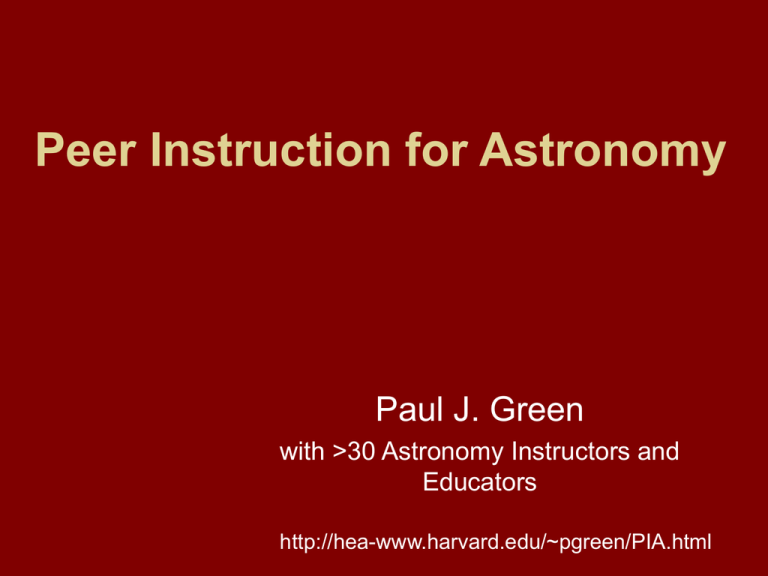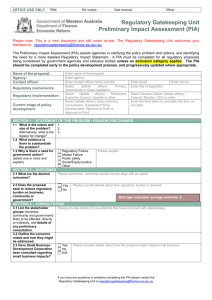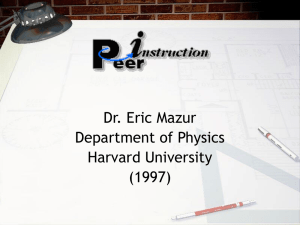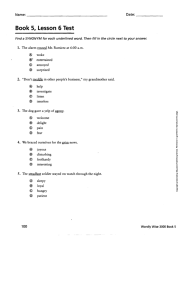Peer Instruction for Astronomy & the Internet
advertisement

Peer Instruction for Astronomy Paul J. Green with >30 Astronomy Instructors and Educators http://hea-www.harvard.edu/~pgreen/PIA.html Imagine a class where the students come prepared because they don't want to let their group down, where they have the confidence to find answers themselves, and where they question each other as well as other sources. http://hea-www.harvard.edu/~pgreen/PIA.html What is Peer Instruction? • An interactive lecture method suitable for Astro101. • A way to engage students in the learning process. • A form of collaborative learning. • Related to techniques with a long history of study and application. (Johnson & Johnson 1993; Mazur 1997) http://hea-www.harvard.edu/~pgreen/PIA.html Classroom Recipe for PIA • • • • Mini-lecture (10 minutes) Pose ConcepTest (1 minute) Quick-read tally (1 minute) If 30-80% correct, students break into peer groups for discussion (2-3 mins) • Re-tally after discussion (1 min) • Discuss and iterate or move on http://hea-www.harvard.edu/~pgreen/PIA.html This space intentionally left blank. http://hea-www.harvard.edu/~pgreen/PIA.html ConcepTest If the Sun were suddenly to be replaced by a solar-mass black hole, the Earth would A) remain in the same orbit B) move into a much smaller orbit C) be pulled into the black hole and disappear D) suddenly disappear http://hea-www.harvard.edu/~pgreen/PIA.html Peer Instruction Should… • improve attention & retention • highlight and address common pre- or misconceptions • increase understanding of key physical concepts • develop ability to communicate scientific ideas • enhance collaborative skills • raise satisfaction with your course • raise class attendance, lower course attrition http://hea-www.harvard.edu/~pgreen/PIA.html A “Long Walk off a Short Peer”? Common Concerns • How can I cover all the course material? • Chaos will reign! • Groups allow students to ‘hide’ and to ride the coattails of more motivated peers. • My students want to be taught by teachers, not by other students! • My colleagues will scoff ! PI is countercultural. It looks like I’m trying to avoid lecturing! http://hea-www.harvard.edu/~pgreen/PIA.html How can I cover all the course material? • Amount heard ↓ Amount learned ↑ ! • Prep can focus on key concepts, rather than on length and density of sermon • Insist on preparation – Reading assignments – Reading quizzes – ConcepTest writing assignments http://hea-www.harvard.edu/~pgreen/PIA.html Chaos will reign! • Well, yes, it will. • But only briefly, because students are eager to know the answer. • Set a firm maximum time limit for discussion, but call a halt if room grows quiet. • Relax! Chaos is a healthy sign. http://hea-www.harvard.edu/~pgreen/PIA.html Order & Disorder “…at these phase transitions the forces leading to order and disorder compete, resulting in states more complex than those away from the transition.” † Lattice interactions (a crystal forms!) • long-range correlations and aligned-spin clusters Evolutionary dynamics (a species evolves!) • Selection-mutation balance • gene stability (for heredity) and genetic diversity and mutation (for species adaptability) Social Catastrophe Theory (society evolves!) • cooperation and conflict theory, peace and war, social movements • Both the structure of expectations and the status quo have high social viscosity, but realignment first demands misalignment. †Crutchfield & Schuster 2002, Evolutionary Dynamics Groups Allow Students to Hide • Techniques of group formation can help circumvent this issue. • Good groups foster – Positive interdependence – Individual accountability http://hea-www.harvard.edu/~pgreen/PIA.html Forming Groups • Group Size – Short discussion time → small size – Small size → greater participation – Too small means too few ideas and interactions. • Self-Assignment tends to form groups with – Students at similar levels – Less diversity – Closer social connections • Random Assignment – Enforces diversity – Breaks up social groups • Grouping Criteria – allows fine-tuning – by achievement, preparation, participation, background, culture… http://hea-www.harvard.edu/~pgreen/PIA.html Forming Groups: Recommendations • Group Size and lifetime – 3-4 students – 2-3 weeks lifetime • Self-Assignment – Good at the outset so students acclimatize • Random Assignment – Simple and effective – Use e.g., by alphabetical or birthdate groupings • Mixed Assignment, e.g., – Within birth month – With the nearest person who chose a different answer • Grouping Criteria – last resort, but can boost learning http://hea-www.harvard.edu/~pgreen/PIA.html Students Want to Be Taught by Teachers! • Actually, you bore them sometimes. • You will be able to focus with them on concepts, not on reciting what they should have read. • You will become both teacher and meta-teacher. • Your role as Socratic mentor is enhanced. • Their role as scientist is enhanced. http://hea-www.harvard.edu/~pgreen/PIA.html My Colleagues Will Scoff! • Tell them in advance that you are trying a novel educational technique. – They may not know unless you tell them! • Tell them it’s not so novel. – Collaborative Learning techniques are well-known – They can stagnate, while you innovate! • Show them when you – raise class attendance – lower course attrition – raise popularity http://hea-www.harvard.edu/~pgreen/PIA.html Prentice-Hall 2002 Peer Instruction: Description Effectiveness Pros & Cons Classroom Recipes What’s a ConcepTest 500 ConcepTests in text, Word, and PDF Assessment of PIA http://hea-www.harvard.edu/~pgreen/PIA.html History of the Internet Project • 1998 – ConcepTest Library opens – password access; requires contribution • 2000 – Over 30 Instructors contribute – Library at 500 ConcepTests – Prentice-Hall suggests a book • 2002 – Many more ConcepTests ready for use & testing – Help!? http://hea-www.harvard.edu/~pgreen/PIA.html http://hea-www.harvard.edu/~pgreen/PIA.html http://hea-www.harvard.edu/~pgreen/PIA.html ConcepTest Grading Generally discouraged, but often useful as a motivator • Individual CT answers can sometimes be collected for a grade • Group answers can too, or can be added to individual grades • Student-composed CTs make a good homework assignment http://hea-www.harvard.edu/~pgreen/PIA.html Overall Grading • Use a variety of evaluators to encourage both individual accountability and cooperative learning • • • • Reading quizzes ConcepTests Problem Sets Midterm and Final • If you make grading transparent, students can keep track for themselves • Curves discourage cooperation and participation http://hea-www.harvard.edu/~pgreen/PIA.html Building A Community Resource on the Internet PASSIVE ENHANCEMENTS • • • • • • Expand Library to >1000 ConcepTests Remove contribution requirement Enhance keyword and topic searches Allow instant display of ConcepTests Add figures & illustrations Track and report ConcepTest popularity via downloads http://hea-www.harvard.edu/~pgreen/PIA.html Active Enhancements & Interactivity on the Internet • Course Tracking – Allows return statistics – Tracking each class with a unique ID and data on institute, course level, teacher, class size • Accrue statistics on ConcepTests – Tally and search by actual usage, fraction correct answers • Enables instructors to shop for appropriate CTs – Answer choice tracking • Allows refinement of distractors – Instructor feedback http://hea-www.harvard.edu/~pgreen/PIA.html Method Assessment • Compare pre- and post-course test results – with and without PIA – repeat in similar circumstances (teacher, institution, course, class size), or use – Relative Gain Index= (%pre-%post)/(100-%post) • Repeat with other courses, instructors • Perform at numerous institutions • This is difficult, costly, unlikely http://hea-www.harvard.edu/~pgreen/PIA.html The Astronomy Diagnostic Test http://solar.physics.montana.edu/aae/adt/ • First version adopted questions from Project STAR (Sadler 1992) • ADT has 33 multiple-choice questions – 12 student background questions – 21 concept / knowledge questions • Validated and Reliable – A wrong answer means the student doesn’t understand. – A right answer usually means the student understands. • Diverse Comparison Database – 3800 students in 22 classes ranging from 6-201 students – 17 institutions of 5 types Pre-Course Results Sample ADT Question Where does the Sun’s energy come from? A. The combining of light elements into heavier elements. B. The breaking apart of heavy elements into lighter ones. C. The glow from molten rocks. D. Heat left over from the Big Bang. E. Did not attempt to answer. No. 420 % 27 870 56 142 9 122 8 3 0 1557 100 Internet Enhancements, Method Assessment and Refinement • NEEDED – instructor/collaborators – a web programmer – $$, NSF CCLI-EMD (Course Curriculum and Laboratory Improvement- Educational Materials Dissemination) – Deadline June 2004 http://hea-www.harvard.edu/~pgreen/PIA.html





